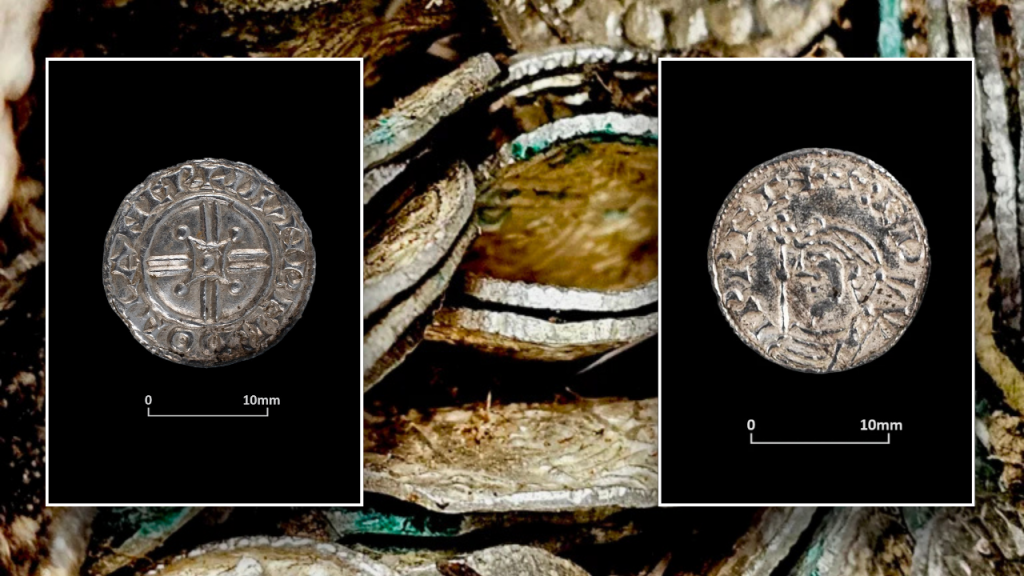The discovery of a 1,000-year-old hoard of silver coins at the Sizewell C nuclear power station site in Suffolk, England, offers a captivating glimpse into the political and economic landscape of 11th-century England. Unearthed by Oxford Cotswold Archaeology (OCA), the 321 coins, dating back to the reigns of Kings Harold I, Harthacnut, and Edward the Confessor, were found remarkably preserved in a lead and cloth package, reminiscent of a Cornish pasty. The coins’ pristine condition and deliberate placement within a likely purse and lead sheeting suggest intentional concealment, possibly at the intersection of ancient field boundaries. This deliberate burial hints at the owner’s desire to safeguard their wealth, perhaps due to the uncertainties surrounding regime changes during that era.
The hoard encompasses coins minted between 1036 and 1044, a period marked by political turbulence and dynastic shifts. Harold I and Harthacnut, sons of Cnut the Great, the first Danish king of England, ruled for relatively short periods before Edward the Confessor ascended the throne. Edward’s coronation in 1043 likely triggered anxieties and instability, as evidenced by the confiscation of property and exile of individuals associated with the previous regime. The owner of the coin hoard, fearing repercussions, might have chosen to bury their savings, intending to retrieve them later. However, fate intervened, and the treasure remained hidden for a millennium, offering present-day archaeologists a unique window into the past.
The coins, primarily struck in London but also originating from other English towns like Thetford, Norwich, Ipswich, Lincoln, and Stamford, represent a significant sum for the time. Totaling 320 pence, including two halfpence coins, the hoard’s value is difficult to translate into modern purchasing power. However, historical records suggest that a cow was worth approximately 20 pence in the 11th century, implying that the hoard could have purchased around 16 cows – a small herd and a substantial investment for an individual. While significant, the hoard does not represent the immense wealth of royalty or national figures. Instead, it likely belonged to a person of local influence, perhaps a prosperous farmer, whose savings reflected their relative affluence within the community.
The discovery underscores the importance of archaeological investigations, even in unexpected locations like construction sites. The Sizewell C nuclear power station project, while focused on the future of energy production, inadvertently unearthed a tangible connection to England’s rich past. The coins, silent witnesses to a tumultuous era, provide valuable insights into the lives and concerns of ordinary individuals navigating the uncertainties of political change. Their rediscovery highlights the enduring power of archaeological discoveries to illuminate history and connect us to the experiences of those who lived centuries ago.
The analysis of the hoard involved a collaborative effort between numismatists, finds specialists, and conservators, ensuring a comprehensive understanding of the coins’ historical context and significance. OCA coin specialist Alexander Bliss emphasizes the hoard’s contribution to our understanding of the period’s historical backdrop, particularly the anxieties surrounding Edward the Confessor’s accession to the throne. The meticulous study of these coins allows researchers to reconstruct the monetary and political landscape of 11th-century England, shedding light on the lives and concerns of individuals beyond the realm of kings and nobles.
The Sizewell C coin hoard, a testament to human ingenuity and the enduring allure of buried treasure, offers a poignant reminder of the uncertainties and challenges faced by individuals in times of political transition. The owner’s decision to conceal their wealth, driven by fear and prudence, preserved a valuable historical artifact that has resurfaced a millennium later, enriching our understanding of the past. The coins, once a symbol of financial security, now serve as a tangible connection to a bygone era, offering a glimpse into the lives, concerns, and economic realities of 11th-century England.

